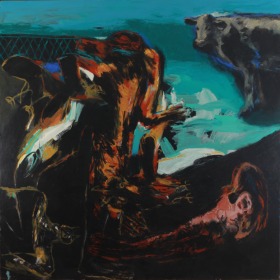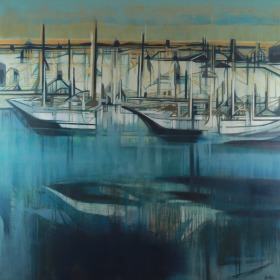You have no items in your cart. Want to get some nice things?
Go shopping
Every time I visit the Herrera-Harfuch art collection, every time I’ve gone up – because there is an ascent, never as dangerous as the descent, even though, often, during the climb one is filled with a glass or two of wine or some other intoxicant, a couple of tequilas or whiskies on winter nights – every time I am under the impression that I have seen only a small fragment of the collection’s great body of work. A slice of an enormous landscape wisely folded into the furrows of the collection’s archives. These wines and spirits consumed before going up accompany the greatest delicacies of Polish cuisine found in Mexico. Everyone knows what their favourite dish is – perhaps a few juicy slices of duck in a sweet-and-sour sauce, fish cooked just right to retain its tenderness and not lose the vigour of the sea, or minced meat wrapped in cabbage leaves drenched in the most delicious red sauce that is orange, really, due to the way the mix of tomatoes and paprika gel during the process of cooking. This is served on white dishes with colourful puréed roots that are so much a part of survival in northern Europe. But back to Mexico City, the Condesa neighbourhood to be exact, where you can eat on the terrace almost year-round. The caloric impact of the delicacies served by Gabriel Herrera take on other dimensions, and I’m not speaking only of the shapes of the diners’ bodies, but of what happens to the perceptions and the minds of those of us who dine here.
The first time (and I don’t know why each time seems to be the first) I passed through a tiny alley next to the restaurant kitchen and went up under the light of the stairs’ bare bulb, a light that undresses the eye in preparation for what lies behind the apartment door. I had moved only a few metres, but found myself as if in another world – the home where the collection lives.
The door opens and one puts one foot after the other into a territory whose first effect is the sensation of having flown a thousand miles away from the Condesa. Simultaneously, one realizes that what has taken place is that one has landed in the very entrails of the neighbourhood. In a place where one can see the pictorial interior of the artists that inhabit the span between the second half of the 20th and into the 21st century. And also the visual touch and flow of a man and of Consuelo, his wife, who have lovingly put together the ripest fruit of these artists. Collecting, let us not forget, is a term that originates from the harvest and also from the time before humans harvested; it is a term derived from the foraging for food in forests, near rivers, in lakes and seas. In what the world was then, in the bounty of the earth.
Behind the door there are works on every centimetre of wall, provided there is space enough for the eye to see. There is art in every nook and cranny, pieces in every corner – to surmise, there are pictures and objects everywhere.

Basically, the collection brings together artists born after 1950, with the exception of Gilberto Aceves Navarro, Pedro Friedeberg, Jose Luis Cuevas, Brian Nissen and Arturo Rivera. Each of these older painters can be seen as an important tributary of a great river that will be discovered in decades to come. These four artists had already started to produce work and gain recognition while the younger generation was being formed under their influence.
Gabriel Herrera says that his interest in art first came from impressions he had at a young age. His mother learned to appreciate painting in her hometown of Tecoh in Yucatan, where she grew up, “humbly, surrounded by orchards, Mayan culture and the Popol Vuh. I remember seeing art as a child,” recounts Herrera, “I don’t remember my level of interest, but I liked it and sensed that I was facing something exceedingly important.” Years later, on a visit to the Met in New York City with his mother, he realized she really knew the paintings, and even identified them: author, subject, everything. “‘Look!’ it appeared she said from one narrow hall to another, ‘that one there is a Brueghel. Brueghel – The Elder. The painting is called The Harvest’”.
That’s how the first seed was planted. Years go by, during which Gabriel Herrera creates the Specia restaurant. In 1995, the collection is born. This collection is now eighteen years old and already has 700 original works and approximately 100 prints and etchings. The collection owes much to the exchange between the collector and the artists without which, Herrera says, it would have been virtually impossible to grow at this rate. Eighteen years are few for the consolidation of such a significant gathering of work. And, as we know is the case in the nascent stage of these endeavours, the exchange that occurs between collector and artist can go far beyond the material sphere, even if the barter happens through it: a canvas, pigments, oil, objects, things that get put together and mixed inside the kitchen of each particular artist.
“I think there are two ways of collecting: the kind that’s done for the love of art, and the sad kind that’s done for financial or social investment. Many of today’s collections are formed by wealthy people who hire dealers and curators who predict what will be important in the future. The last thing these people have in mind is consistency in the quality of the objects gathered. They buy signatures and acquire artists that will help them gain social status regardless of whether the work excites or transmits something. What matters is that it is fashionable. That cold indifference is felt and makes the collection something soulless, without historical reason and without poetry.

“It is a fact that collecting art is a reflection of the desire to possess beauty. What is more enriching for the soul than beauty? That’s why I wonder what collectors of empty boxes and balloons must feel,” Herrera says.
The experience of exchanging is different from the experience of buying. “I never set out to be a collector. One day I realized that I already had many paintings and other works of art. Museums and exhibits started to request pieces, and I understood something important had happened through my friendship with these artists. These relationships have developed naturally. Much of what I’ve collected is related to the endless conversations I’ve had with the artists.
“Artists are different kinds of beings than you and I; they’re in constant turmoil, their soul on tenterhooks. Gabriel Macotela and Gustavo Monroy are both artists with whom I’ve developed strong bonds of friendship. They are an essential part of the collection. Gustavo Monroy is a painter who works with unpleasant themes and is one of the greatest artists I know. It was with him that I understood that people don’t like to be confronted with difficult works because, in most cases, it confronts them with themselves, and that is not easy – especially if you don’t know who you really are. I don’t like collecting landscapes and still lifes; I think art should make you shudder, make you think and analyse the reason for existence. Jorge Alzaga (now deceased) for example, was one of the painters who, although perhaps not a great artist, was an extraordinary human being who taught me to look at art with watchful eyes.”
In the apartment that the collection and its meticulous records and files inhabit, there is a flavour – the inevitable result of the confusion between sight and taste under these circumstances – which is elusive, hard to grasp. I explain it to myself by inventing a story: Someone extraordinarily careful from the aforementioned generation had the good fortune of living in the same nice, spacious apartment since the Eighties and stayed there. He stayed there without collecting dust, or old shoes, or dead files filled with decades of phone bills and extinct bank accounts. Neither did he gather burnt pans, nor synthetic clothing turned to shreds that hurt the skin. No, this person even bottled the light coming through the window during those years: particularly dense but not devoid of beauty. And he collected the images and forms born of that light. He meticulously recorded the history and provenance of each piece, simplifying art historians’ lives. A silence envelops the visitor. A silence that is not reverential but contemplative, inquisitive. Perhaps the gaze of Gabriel himself. The love of having gathered the voices. Forgive me, synaesthesia wins: the gathering of flavours that are images that are voices that make up the collection.
Over the years, stories have come to hang from the paintings that hang on the walls. Captions or narrative records that adhere to the image and enrich the texture of the object, as if adding another layer of depth, of sense, of significance.
Gabriel recounts, “One afternoon I visited Gabriel Macotela, who was painting a boat onto a beautiful fabric for a collector from Valle de Bravo. I told him I’d like to have something similar. He told me he’d paint me an entire fleet. I had a frame of 1.98m by 1.98m made. I had the finest linen I could find stretched over it. It didn’t enter his study so he worked on it in a warehouse I have next to the apartment. He painted it there. It’s called Sea of Our Lives. I documented the creative process photographically and now the painting hangs in front of Consuelo’s desk. It’s one of the dearest pieces in our collection.”
These works seem to have a life of their own. The paintings develop close relationships and converse among each other. We are talking here about a crude reality, a group of artists who look at the exterior and interior world without any prohibitions and without trying to please anyone. For example, the large paintings by Daniel Lezama don’t correspond to any official version of the nation’s history. They correspond with his story, his own. His visions hit you hard and are not easy to digest. Herrera appreciates raw truth.
The four children of the Herrera-Harfuch marriage grew up among the collection and the challenges it faced. Herrera recounts a beautiful story of how one of his daughters offered to leave college when she found out he couldn’t raise the money to keep an incredible painting of Daniel Lezama’s, The Prodigal Mother. She suggested he use her tuition money to pay for it. The father didn’t accept his daughter’s sacrifice. The painting went to a European collection.
A man and a woman unite, create a family, and find a way to provide for that family. Art enters the construction through a natural opening. The collection grows with dedication and a special spice that visits the Specia restaurant. There’s something easy about its growth, similar to the way plants grow with water and sunlight. What matters most in life is the life lived – the collection of precious moments that occur and in which we shift from one group of people to another in the passing of time and generations. There are cases in which images adhere to families – images produced by primitive tools, animal hair attached to pieces of wood and securely fastened with string or wire, which allow pigments to glide over fabric. Or images created with the help of chisels, rasps, sandpaper… Images that will survive us all and which the collector lovingly rescues from the studios of those who need to register the liquid flow of the visual.
Translation by Sylvia Blackmore

About Aline Davidoff
Aline Davidoff studied literature at the New York School in New York. Her career passes between the performing arts and writing. She is currently president of PEN Mexico.




